SpringMVC系列 教程(六):拦截器详解(附源码分析)

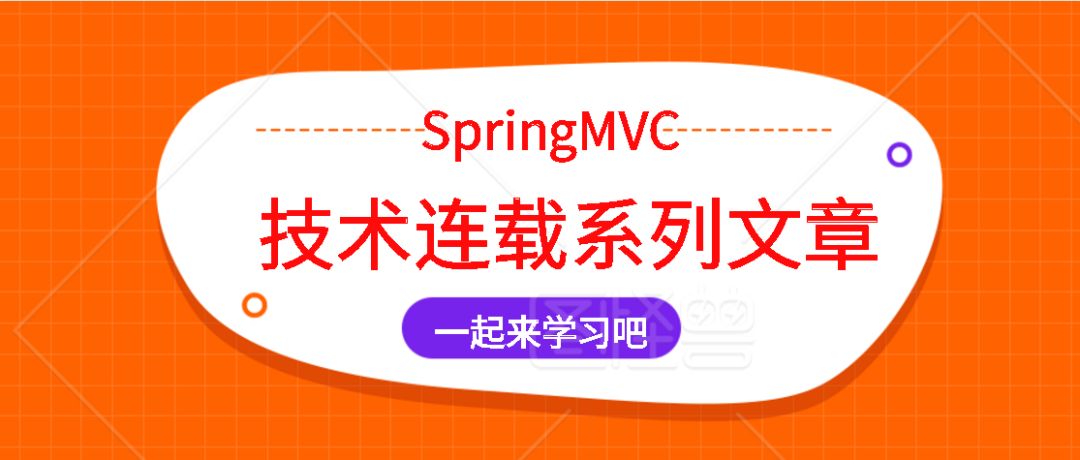
来源:https://www.cnblogs.com/
fangjian0423/p/springMVC-interceptor.html
一. 前言SpringMVC是目前主流的Web MVC框架之一。
拦截器是每个Web框架必备的功能,也是个老生常谈的主题了。
本文将分析SpringMVC的拦截器功能是如何设计的,让读者了解该功能设计的原理。
二. 重要接口及类介绍1. HandlerExecutionChain类
由HandlerMethod和Interceptor集合组成的类,会被HandlerMapping接口的getHandler方法获取。

2. HandlerInterceptor接口

SpringMVC拦截器基础接口。
3. AbstractHandlerMapping
HandlerMapping的基础抽象类。

4. AsyncHandlerInterceptor
继承HandlerInterceptor的接口,额外提供了afterConcurrentHandlingStarted方法,该方法是用来处理异步请求。当Controller中有异步请求方法的时候会触发该方法。楼主做过测试,异步请求先支持preHandle、然后执行afterConcurrentHandlingStarted。异步线程完成之后执行preHandle、postHandle、afterCompletion。有兴趣的读者可自行研究。
5. HandlerInterceptorAdapter
实现AsyncHandlerInterceptor接口的抽象类,一般我们使用拦截器的话都会继承这个类。然后复写相应的方法。
6. WebRequestInterceptor
与HandlerInterceptor接口类似,区别是WebRequestInterceptor的preHandle没有返回值。还有WebRequestInterceptor是针对请求的,接口方法参数中没有response。
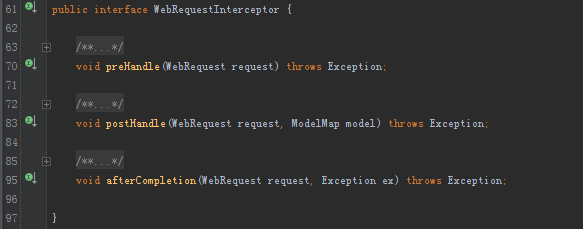
AbstractHandlerMapping内部的interceptors是个Object类型集合。处理的时候判断为MappedInterceptor[加入到mappedInterceptors集合中];HandlerInterceptor、WebRequestInterceptor(适配成WebRequestHandlerInterceptorAdapter)[加入到adaptedInterceptors中]
7. MappedInterceptor
一个包括includePatterns和excludePatterns字符串集合并带有HandlerInterceptor的类。很明显,就是对于某些地址做特殊包括和排除的拦截器。

8. ConversionServiceExposingInterceptor
默认的
首先我们看下拦截器的如何被调用的。
Web请求被DispatcherServlet截获后,会调用DispatcherServlet的doDispatcher方法。
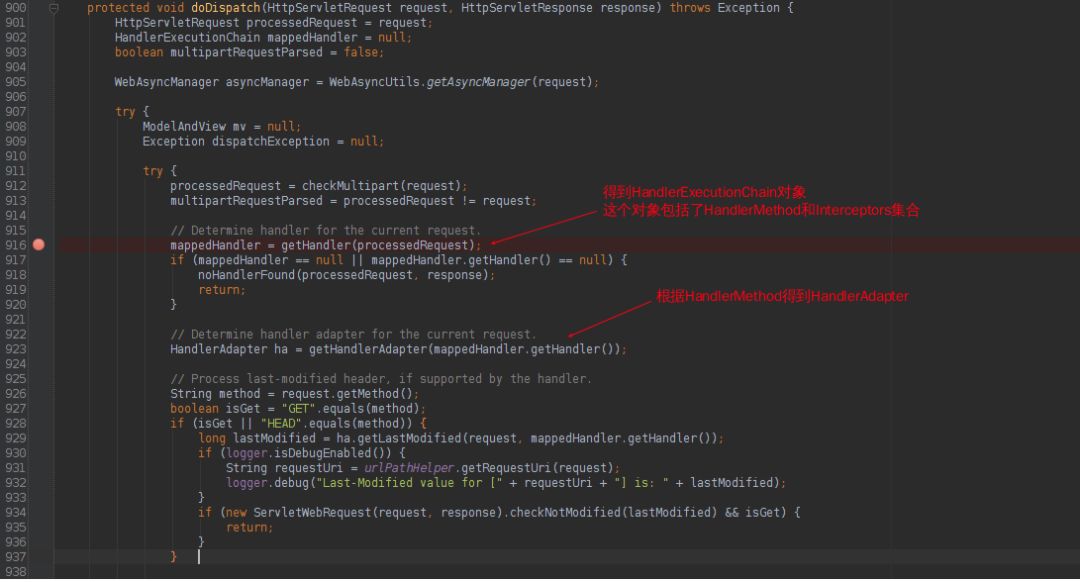
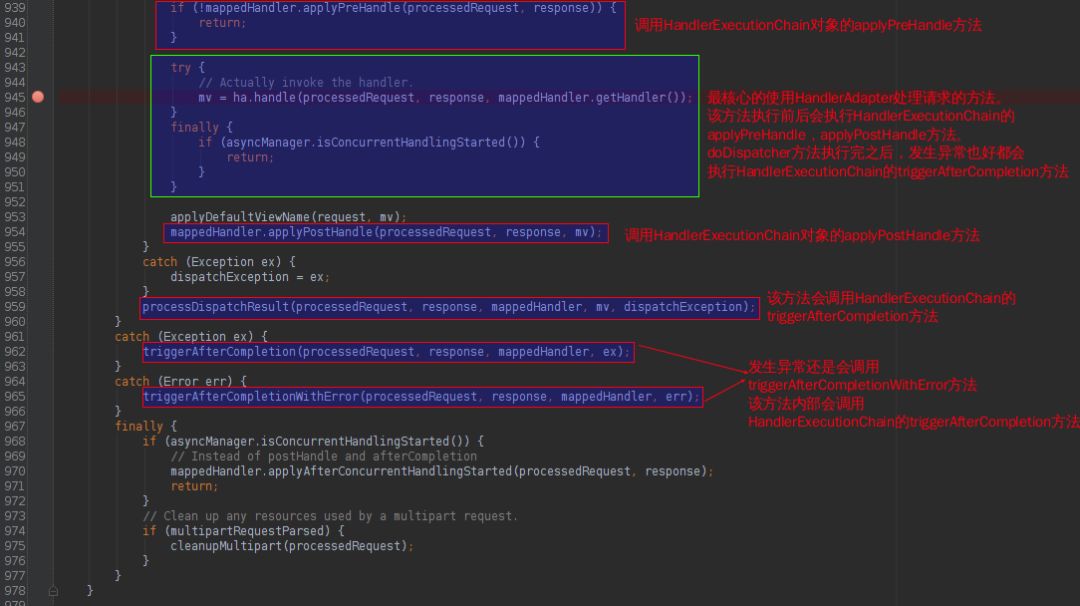
很明显地看到,在HandlerAdapter处理之后,以及处理完成之后会调用HandlerExecutionChain的方法。
HandlerExecutionChain的applyPreHandle、applyPostHandle、triggerAfterCompletion方法如下:



很明显,就是调用内部实现HandlerInterceptor该接口集合的各个对应方法。
下面我们看下HandlerExecutionChain的构造过程。
HandlerExecutionChain是从HandlerMapping接口的getHandler方法获取的。
HandlerMapping的基础抽象类AbstractHandlerMapping中:
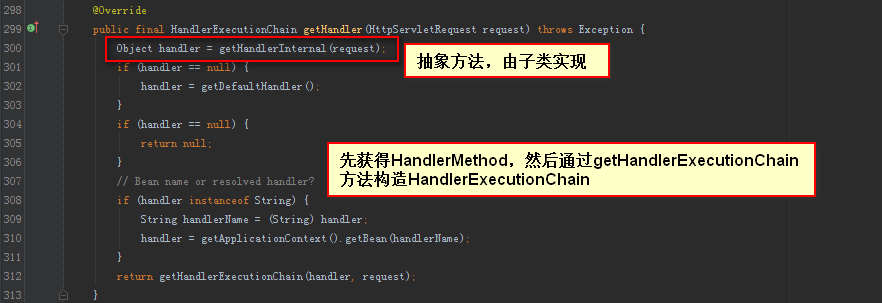

我们看到,HandlerExecutionChain的拦截器是从AbstractHandlerMapping中的adaptedInterceptors和mappedInterceptors属性中获取的。
四. 拦截器的配置清楚了HandlerExecutionChain的拦截器属性如何构造之后,下面来看下SpringMVC是如何配置拦截器的。
1. *-dispatcher.xml配置文件中添加
<mvc:interceptors><mvc:interceptor><mvc:mapping path="/**"/><mvc:exclude-mapping path="/login"/><mvc:exclude-mapping path="/index"/><bean class="package.interceptor.XXInterceptor"/>mvc:interceptor>mvc:interceptors>
这里配置的每个
其中子标签

2. 配置RequestMappingHandlerMapping,并配置该bean对应的interceptors集合属性。这里的interceptors集合是个Object类型的泛型集合。
AbstractHandlerMapping抽象类只暴露了1个拦截器的set方法 -> interceptors。
adaptedInterceptors和mappedInterceptors均没有暴露set方法,因此我们只能为RequestMappingHandlerMapping配置interceptors属性。
其实AbstractHandlerMapping内部的initInterceptors方法中,会遍历interceptors集合,然后判断各个项是否是MappedInterceptor、HandlerInterceptor、WebRequestInterceptor。
其中MappedInterceptor类型的拦截器会被加到mappedInterceptors集合中,HandlerInterceptor类型的会被加到adaptedInterceptors集合中,WebRequestInterceptor类型的会被适配成WebRequestHandlerInterceptorAdapter加到adaptedInterceptors集合中。


如果读者配置了:
那么配置如下:
class ="org.springframework.web.servlet.mvc.method.annotation.RequestMappingHandlerMapping"><property name="interceptors"><bean class="package.interceptor.XXInterceptor"/>property><property name="order" value="-1"/>bean>
否则,可以去掉order这个属性的设置。
一般建议使用第一种方法。
五. 编写自定义的拦截器public class LoginInterceptor extends HandlerInterceptorAdapter {public boolean preHandle(HttpServletRequest request, HttpServletResponse response,Object handler) throws Exception {// 获得请求路径的uriString uri = request.getRequestURI();// 判断路径是登出还是登录验证,是这两者之一的话执行Controller中定义的方法if(uri.endsWith("/login/auth") || uri.endsWith("/login/out")) {return true;}// 进入登录页面,判断session中是否有key,有的话重定向到首页,否则进入登录界面if(uri.endsWith("/login/") || uri.endsWith("/login")) {if(request.getSession() != null && request.getSession().getAttribute("loginUser") != null) {response.sendRedirect(request.getContextPath() + "/index");} else {return true;}}// 其他情况判断session中是否有key,有的话继续用户的操作if(request.getSession() != null && request.getSession().getAttribute("loginUser") != null) {return true;}// 最后的情况就是进入登录页面response.sendRedirect(request.getContextPath() + "/login");return false;}}
登录Controller:
public class LoginController {public String index() {return "login";}public String auth( String username, HttpServletRequest req) {req.getSession().setAttribute("loginUser", username);return "redirect:/index";}public String out(HttpServletRequest req) {req.getSession().removeAttribute("loginUser");return "redirect:/login";}}
*-diapatcher.xml配置:
<mvc:interceptors><mvc:interceptor><mvc:mapping path="/**"/><bean class="org.format.demo.interceptor.LoginInterceptor"/>mvc:interceptor>mvc:interceptors>
PS:我们看到LoginInterceptor里的preHandle方法对于地址“/login/auth”和"/login/out"不处理。
因此,可以写点配置,少写带java代码。在拦截器配置中添加2个exclude-mapping,并且去掉LoginInterceptor里的
if(uri.endsWith("/login/auth") || uri.endsWith("/login/out")) {return true;}
配置新增:
<mvc:exclude-mapping path="/login/out"/><mvc:exclude-mapping path="/login/auth"/>
六. 小结
总结了SpringMVC拦截器的原理以及各种配置,像网上很多人会问为什么拦截器执行preHandle方法返回false之后还是会执行afterCompletion方法,其实我们看下源码就知道了。
关于异步请求方面的拦截器以及第二种配置方法(interceptors集合属性可加入继承自HandlerInterceptorAdapter抽象类的类以及实现WebRequestInterceptor接口的类),读者可自行研究。
文中难免有错误,希望读者能够指出来。
- End -

技术连载目录(可点击跳转即可阅读):
面试题系列教程 点击--> 面试题技术干货连载目录 跳转
Maven系列教程 点击--> Maven技术干货连载目录 跳转
MyBatis系列教程 点击--> MyBatis技术干货连载目录 跳转
JVM调优总结系列教程 点击--> JVM调优技术干货连载目录 跳转
点击在看,愿你我不再陌生 ![]()
